Calculation and Analysis of Rotor Thermal Static Field for Inter-Turn Short Circuit of Large Hydro-Generator Excitation Winding
Abstract
:1. Introduction
2. Establishment of Solving Model
2.1. Heat Transfer Theory
2.2. Thermal Stress Theory
2.3. Physical Model
- (1)
- The calculation model for one magnetic pole of the hydro-generator is established given that all rotor magnetic poles and wind paths of the hydro-generator are symmetrical.
- (2)
- The average values of air temperature are taken on the windward side and the leeward side of the excitation winding respectively.
- (3)
- The complex interface of the actual excitation coil is simplified to right angle connection.
- (4)
- The rotor winding insulation of the Three Gorges hydro-generator is Nomex paper. The heat conduction coefficient about the insulation of excitation winding is set to the same as Nomex paper. The insulation between the winding and core is set to an equivalent heat conduction coefficient.
- (5)
- The heat conduction coefficient of the rotor core is anisotropic in the temperature calculation.
- (6)
- The inter-turn short circuit cases in this paper all belong to a metallic short circuit. In the case of a metallic short circuit, there is no direct current in the shorted copper coil, and there is no copper loss at the short circuit point, and the current flows directly through the short circuit point.
- (7)
- The stress, strain, displacement, and other parameters generated by the load are all continuous functions in the structure involved in the magnetic pole model.
- (8)
- Each part of the magnetic pole is completely elastic, that is, the deformation of the object under external load can completely recover after unloading without any residual deformation.
3. Determination of Boundary Conditions and Related Parameters
3.1. Boundary Conditions of Temperature Field
3.2. Boundary Conditions of Thermal Stress Field
3.3. Rotor Loss of Hydro-Generator
- (1)
- The stray losses caused by the magnetomotive force harmonic waves of the stator winding in the damping winding [23].where ; ; ; . p is the number of generator pole pairs; is the number of damping strips; lB is length of a damping strip; CB is the ratio of resistance coefficient of the damping strip to copper resistance coefficient; AB is the section area of the damping strip; dB is diameter of the damping strip; δ is gap length; τ is pole pitch; kδ is total air gap coefficient; Fδ is the magnetic potential drop of the air gap; t2 is the pitch of the rotor damping strip; hn2 is the notch height of the damping slot; bn2 is the notch width of the damping slot; δ′ is the length of the calculation air gap; xad is the reactive reactance of the longitudinal axis armature.
- (2)
- Surface losses of pole shoes at no-load rated voltagewhere ∆ is the thickness of the magnetic plate; kδ1 is the air gap coefficient of the stator slot; Bδ is average magnetic density of air gaps within pole shoes; t1 is stator pitch; Ap is the calculation area of pole shoe surface.
3.4. Heat Transfer Coefficients of the Magnetic Poles and Excitation Windings of the Hydro-Generator
3.5. Effect of Rotor Winding Inter-Turn Short Circuit Current
4. Calculation of Temperature Field in Rotor Winding Inter-Turn Short Circuit
4.1. Temperature Field of Rotor Magnetic Pole under Normal Excitation Winding
4.2. Effect of Inter-Turn Short Circuit on Temperature of Excitation Winding
4.3. Effect of Inter-Turn Short Circuit on the Whole Temperature Field of Magnetic Pole
5. Thermal Deformation of Rotor Winding Inter-Turn Short Circuit
6. Calculation of Thermal Stress in Rotor Winding Inter-Turn Short Circuit
6.1. Effect of the Number of Short Circuit Turns on Thermal Stress Distribution
6.2. Effect of Inter-Turn Short Circuit Position on Thermal Stress Distribution
7. Conclusions
- (1)
- When the short circuit occurs, the whole temperature of the magnetic pole decreases. The more shorted turns there are, the more obvious the temperature change is. Among them, when the inter-turn short circuit occurs in the middle winding of the magnetic pole, the distribution of the temperature fields of the surrounding excitation windings and magnetic poles is greatly affected. The maximum temperature of magnetic pole decreases greatly, and the lowest temperature and position remain basically unchanged. When the short circuit occurs near the pole shoe and the pigeon tail end of the excitation winding, the effect on the distribution of the whole temperature field of the magnetic pole is relatively small. The maximum temperature changes slightly. The lowest temperature decreases and the position of the lowest temperature point change accordingly. The diagnosis of inter-turn short circuit can be realized by monitoring the change of the rotor temperature.
- (2)
- With the increasing number of shorted turns, the whole thermal deformation of the magnetic pole decreases. The thermal deformation of the excitation winding far away from the short circuit turns would increase. At the same time, the changes of the excitation winding temperature result in the deformations in the excitation winding not being uniform.
- (3)
- When a turn short circuit occurs, the thermal stress of the shorted turn increases. When a multi-turn short circuit occurs, the thermal stress of the shorted turns decreases. The greater the number of shorted turns, the greater the reduction of thermal stress, in which larger tensile stress would occur in the shorted turns along the X-direction. The thermal stress of the shorted turn decreases by a small extent when the inter-turn short circuit fault occurs in the middle of the magnetic pole, and the thermal stress decreases greatly when it occurs at the pole shoe end and the pigeon tail end.
Author Contributions
Funding
Conflicts of Interest
References
- Wang, L.; Li, Y.; Li, J. Diagnosis of inter-turn short circuit of synchronous generator rotor winding based on volterra kernel identification. Energies 2018, 11, 2524. [Google Scholar] [CrossRef]
- Li, Y.; Wang, L.; Ma, M. Diagnosis of rotor winding inter-turn short circuit of hydro-generator based on no-load curve reverse calculation. IEEJ Trans. Electr. Electron. Eng. 2019, 14, 130–137. [Google Scholar] [CrossRef]
- Wu, Y.; Li, Y. Diagnosis of rotor winding interturn short circuit in turbine generators using virtual power. IEEE Trans. Energy Convers. 2015, 30, 183–188. [Google Scholar]
- Hao, L.; Wu, J.; Zhou, Y. Theoretical analysis and calculation model of the electromagnetic torque of nonsalient-pole synchronous machines with interturn short circuit in field windings. IEEE Trans. Energy Convers. 2015, 30, 110–121. [Google Scholar] [CrossRef]
- Li, W.; Li, Y.; Su, Y.; Wang, P.; Liu, W. Research on stator main insulation temperature field of air-cooled turbo-generator after main insulation shelling. Energies 2018, 11, 1101. [Google Scholar] [CrossRef]
- Li, D.; Wen, Y.; Li, W.; Feng, B.; Cao, J. Three-dimensional temperature field calculation and analysis of an axial-radial flux-type permanent magnet synchronous motor. Energies 2018, 11, 1208. [Google Scholar] [CrossRef]
- Li, W.; Han, J.; Huo, F.; Zhou, X.; Zhang, Y.; Li, Y. Influence of the end ventilation structure change on the temperature distribution in the end region of large water–hydrogen–hydrogen cooled turbogenerator. IEEE Trans. Energy Convers. 2013, 28, 278–288. [Google Scholar]
- Lu, Y.; Li, W.; Ma, X.; Jin, H. Numerical simulation of temperature field in rotor of large turbo generator with air-coolant. Proc. CSEE 2007, 27, 7–13. [Google Scholar]
- Qiu, H.; Yi, R.; Li, W.; Jin, N. Influence of rectifiers on high-speed permanent magnet generator electromagnetic and temperature fields in distributed power generation systems. IEEE Trans. Energy Convers. 2015, 30, 655–662. [Google Scholar]
- Li, W.; Guan, C.; Chen, Y. Influence of rotation on rotor fluid and temperature distribution in a large air-cooled hydrogenerator. IEEE Trans. Energy Convers. 2013, 28, 117–124. [Google Scholar]
- Wang, L.; Chen, W.; Tao, D.; Li, W.; Ge, B. Research on the impact of screen properties on eddy current and flux in end region of a large air-cooled turbo-generator. IEEE Trans. Energy Convers 2016, 31, 218–227. [Google Scholar] [CrossRef]
- Li, W.; Zhang, Y.; Chen, Y. Calculation and analysis of heat transfer coefficients and temperature fields of air-cooled large hydro-generator rotor excitation windings. IEEE Trans. Energy Convers. 2011, 26, 946–952. [Google Scholar]
- Li, W.; Li, D.; Li, J. Influence of rotor radial ventilation ducts number on temperature distribution of rotor excitation winding and fluid flow state between two poles of a fully air-cooled hydro-generator. IEEE Trans. Ind. Electron. 2017, 64, 3767–3775. [Google Scholar] [CrossRef]
- Ma, M.; Li, Y.; Wu, Y.; Dong, C. Multifield calculation and analysis of excitation winding interturn short circuit fault in turbo-generator. Energies 2018, 10, 2626. [Google Scholar] [CrossRef]
- Carlos, C.; Yinan, L.; Lizon, M. Thermal signature analysis of an 8/6 switched reluctance motor under inter-turn short circuit fault. In Proceedings of the IEEE International Conference on Industrial Technology (ICIT), Lyon, France, 20–22 February 2018; pp. 1859–1864. [Google Scholar]
- Da Costa Bortoni, E.; Siniscalchi, R.T.; Jardini, J.A. Determination of hydro generator efficiency using infrared thermal imaging techniques. IEEE Trans. Energy Convers. 2011, 26, 1134–1139. [Google Scholar] [CrossRef]
- Ashtiani, C.N.; Lowther, D.A. Simulation of the transient and subtransient reactance of a large hydrogenerator by finite elements. IEEE Trans. Power App. Syst. 1984, PAS-103, 1788–1794. [Google Scholar] [CrossRef]
- Nathenson, R.D.; Cherepko, J.; Patel, M.R. Thermal stress analysis and design of the stator of a 300 MVA superconducting generator. IEEE Trans. Energy Convers. 1986, EC-1, 141–147. [Google Scholar] [CrossRef]
- Istad, M.; Runde, M.; Nysveen, A. A review of results from thermal cycling tests of hydrogenerator stator windings. IEEE Trans. Energy Convers. 2011, 26, 890–903. [Google Scholar] [CrossRef]
- Sharifi, E.; Jayaram, S.H.; Cherney, E.A. Analysis of thermal stresses in medium-voltage motor coils under repetitive fast pulse and high-frequency voltages. IEEE Trans. Dielectr. Electr. Insul. 2010, 17, 1378–1384. [Google Scholar] [CrossRef]
- Xie, Y.; Guo, J.; Chen, P.; Li, Z. Coupled fluid-thermal analysis for induction motors with broken bars operating under the rated load. Energies 2018, 11, 2024. [Google Scholar] [CrossRef]
- Wu, Y.; Ma, M.; Li, Y. A new detection coil capable of performing online diagnosis of excitation winding short circuits in steam-turbine generators. IEEE Trans. Energy Convers. 2018, 33, 106–115. [Google Scholar]
- Wu, Y.; Li, Y. Diagnosis of short circuit faults within turbogenerator excitation winding based on the expected electromotive force method. IEEE Trans. Energy Convers. 2016, 31, 706–713. [Google Scholar]
- Kim, J.K.; Kwak, S.Y.; Cho, S.M.; Jung, H.K.; Chung, T.K.; Jung, S.Y. Optimization of multilayer buried magnet synchronous machine combined with stress and thermal analysis. IEEE Trans. Magn. 2006, 42, 1023–1026. [Google Scholar]
- Chen, X. Electromagnetic Analysis and Calculation of Hydro Generator; China Water Conservancy and Hydropower Press: Beijing, China, 2011. [Google Scholar]
- Bi, C.; Hu, L.; Han, B. The online monitoring system of rotor temperature on three gorges hydro generator. Large Electr. Mach. Hydraul. Turbine 2008, 5, 1–4. [Google Scholar]

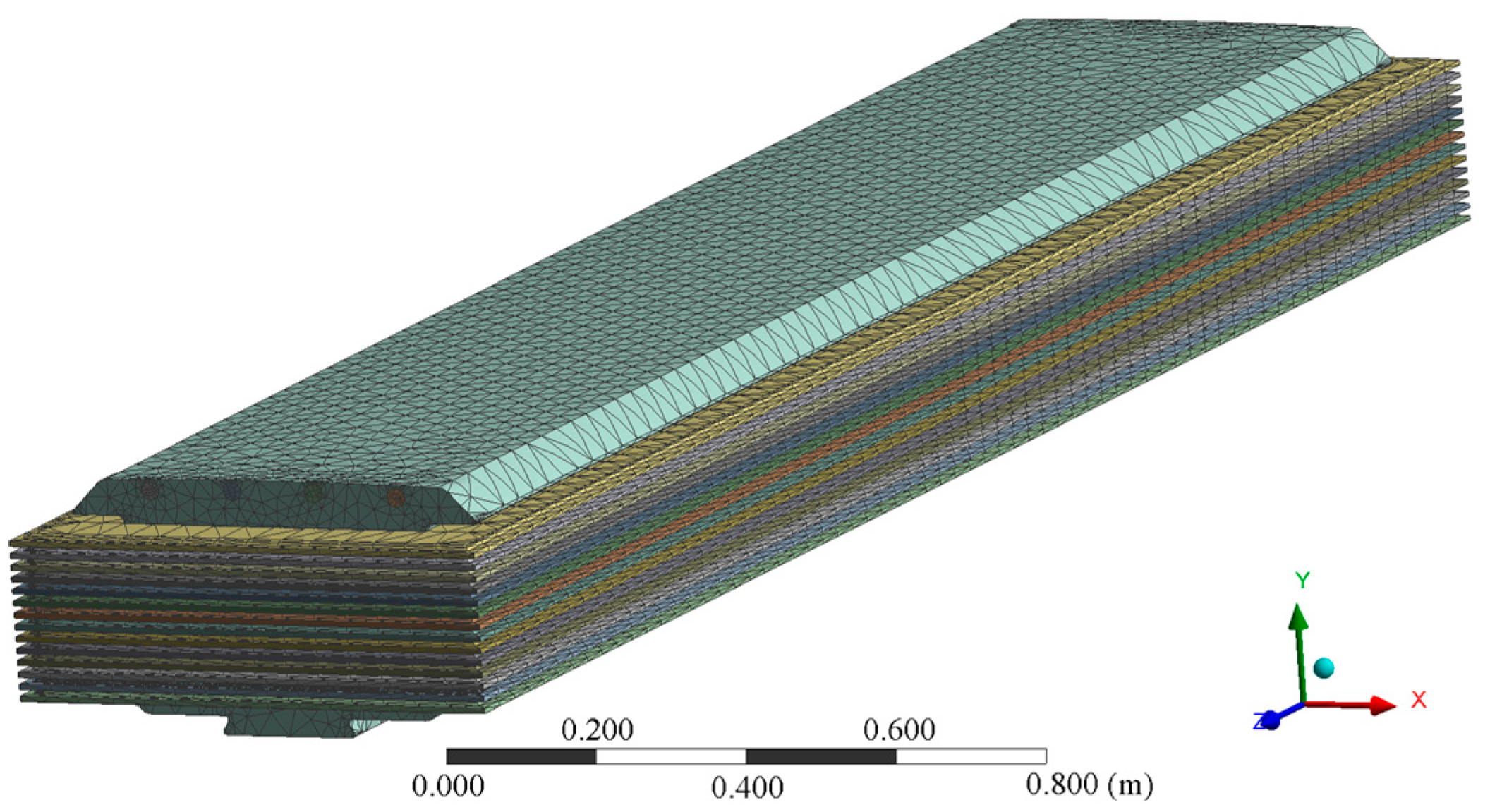

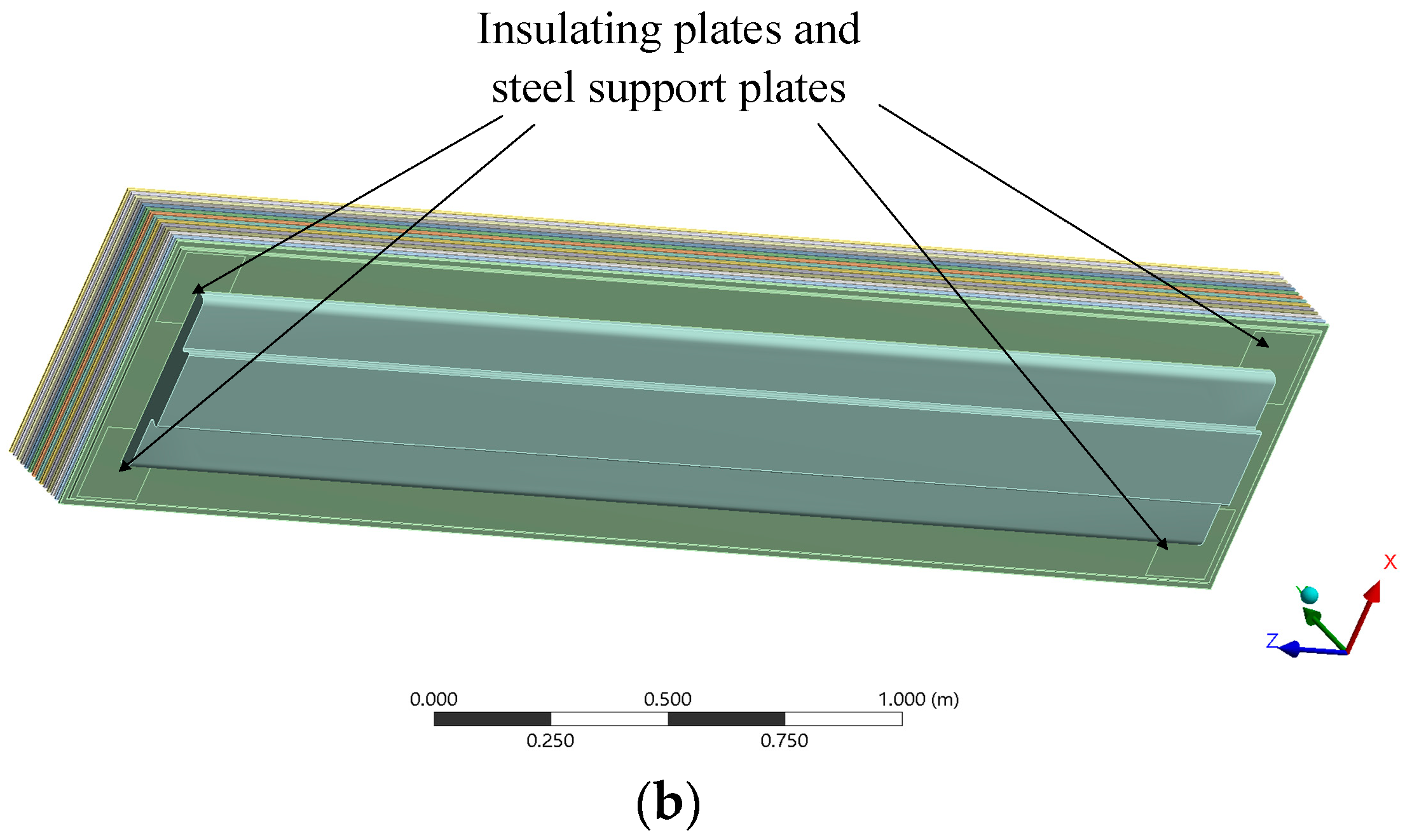
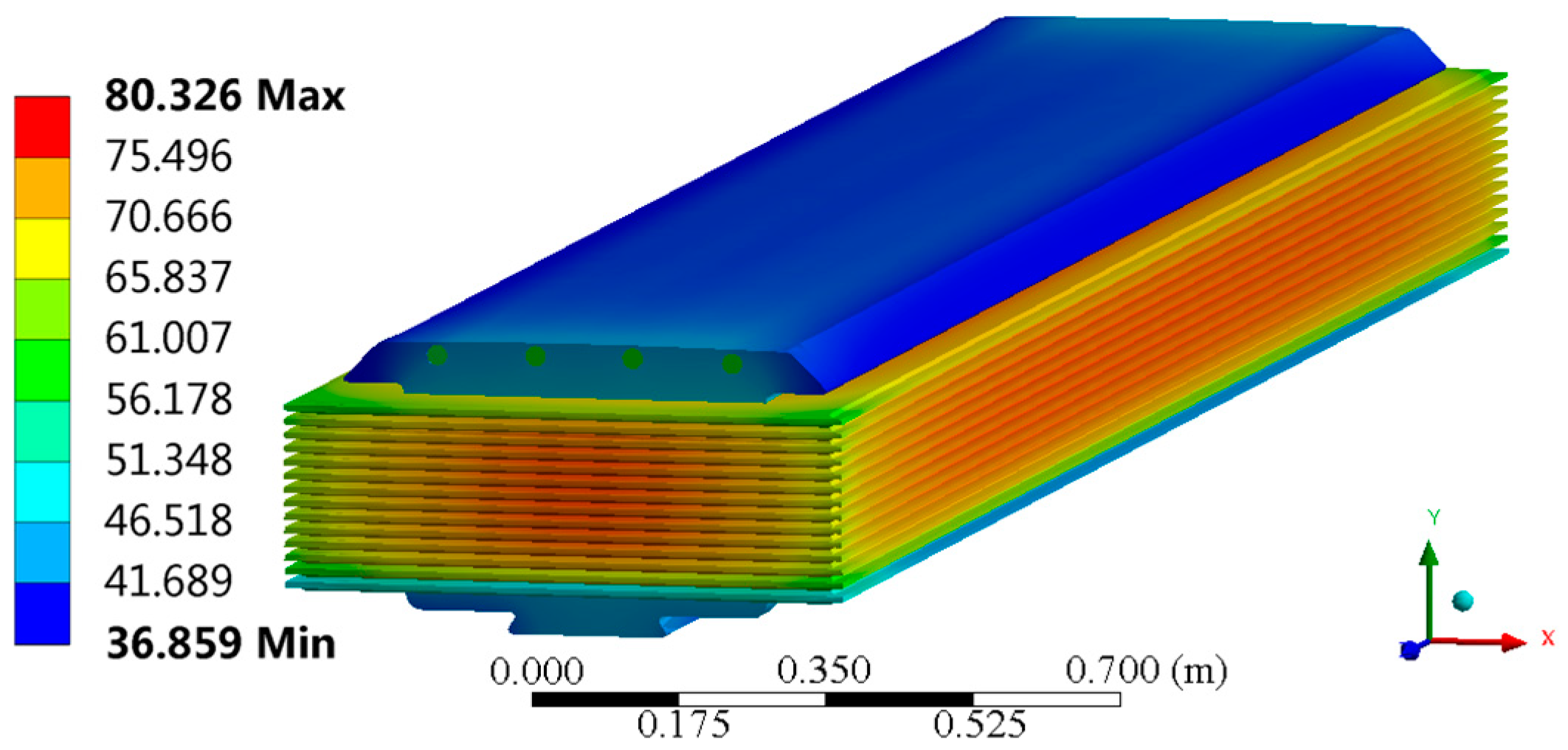


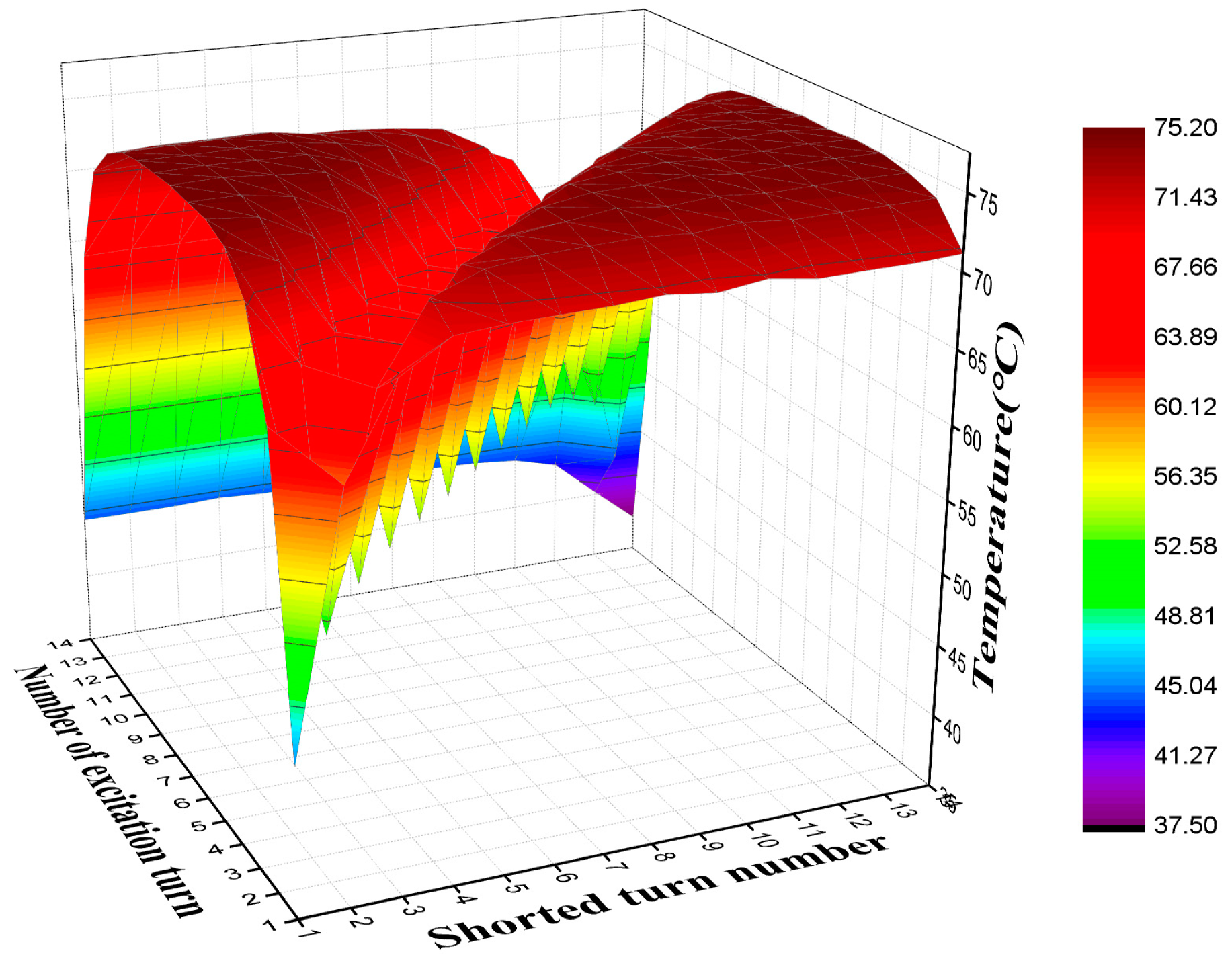
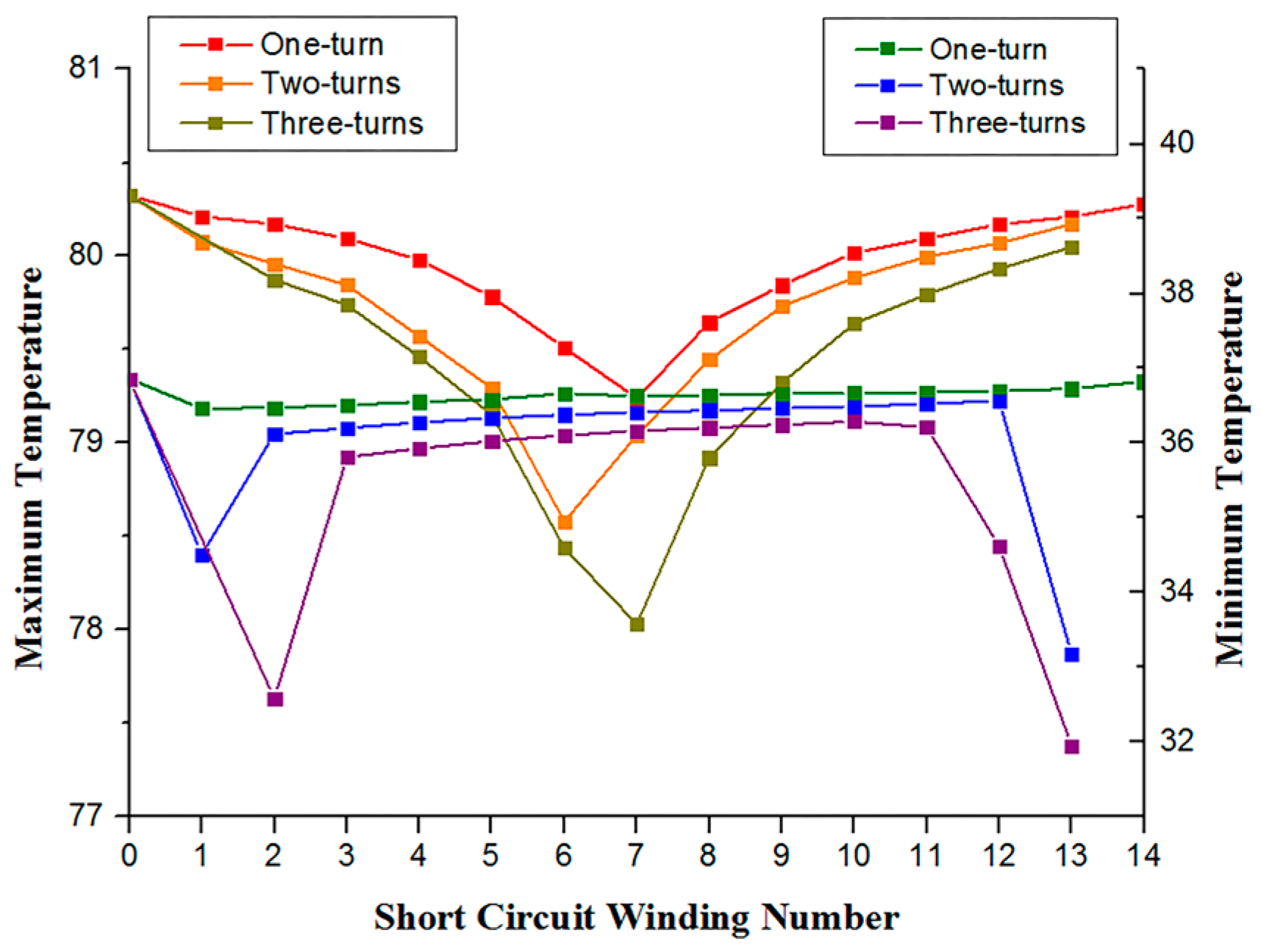
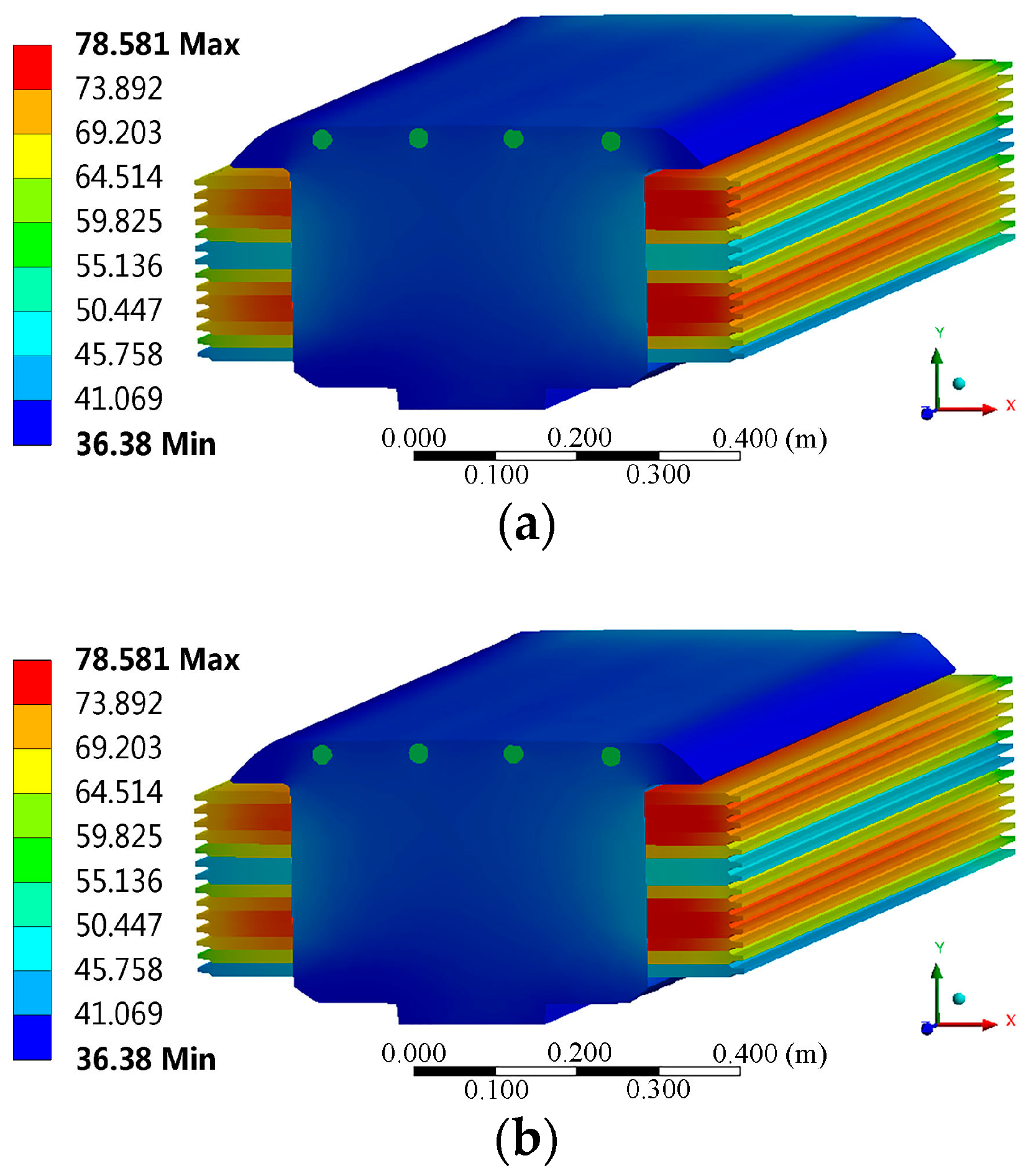
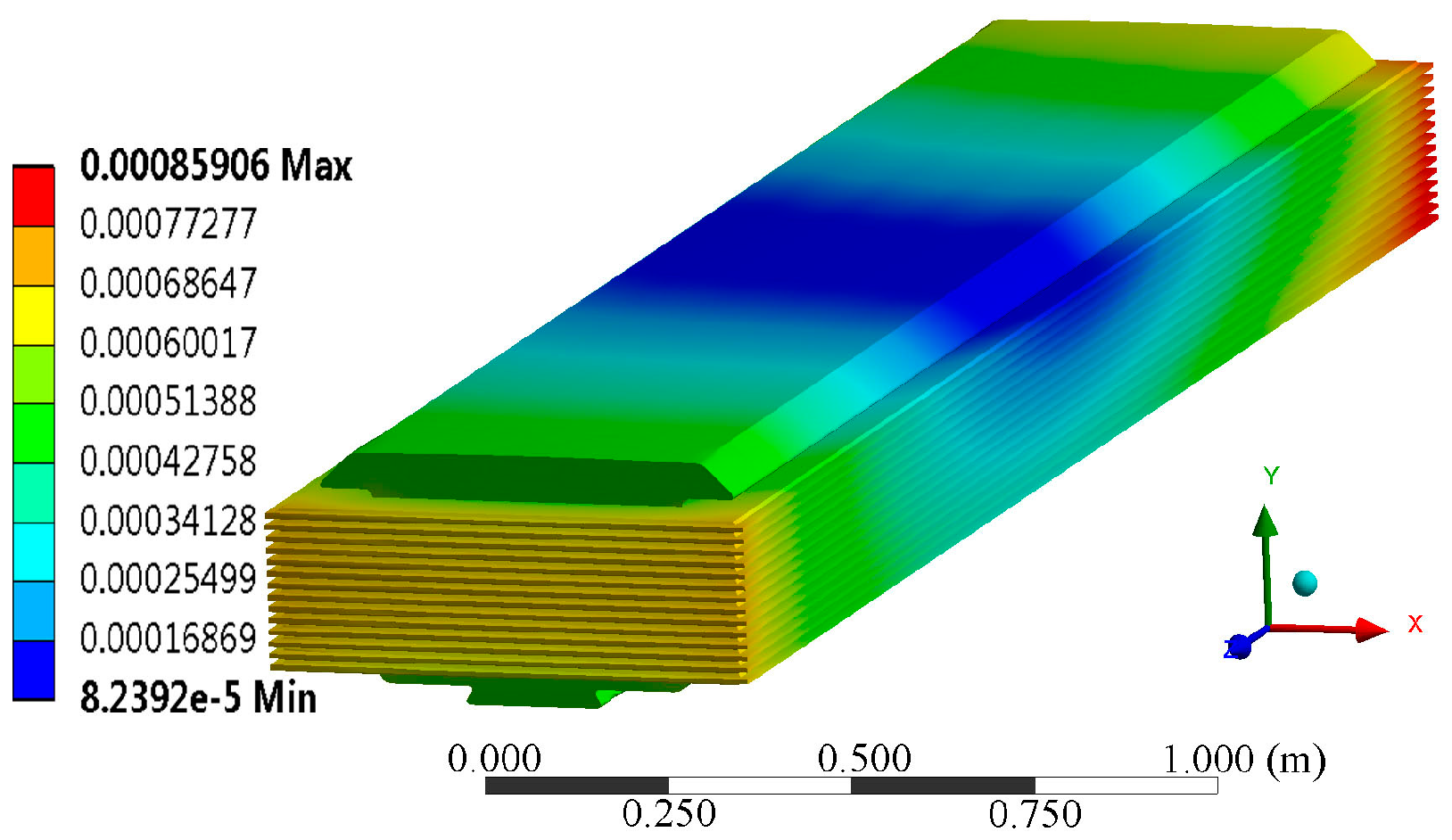
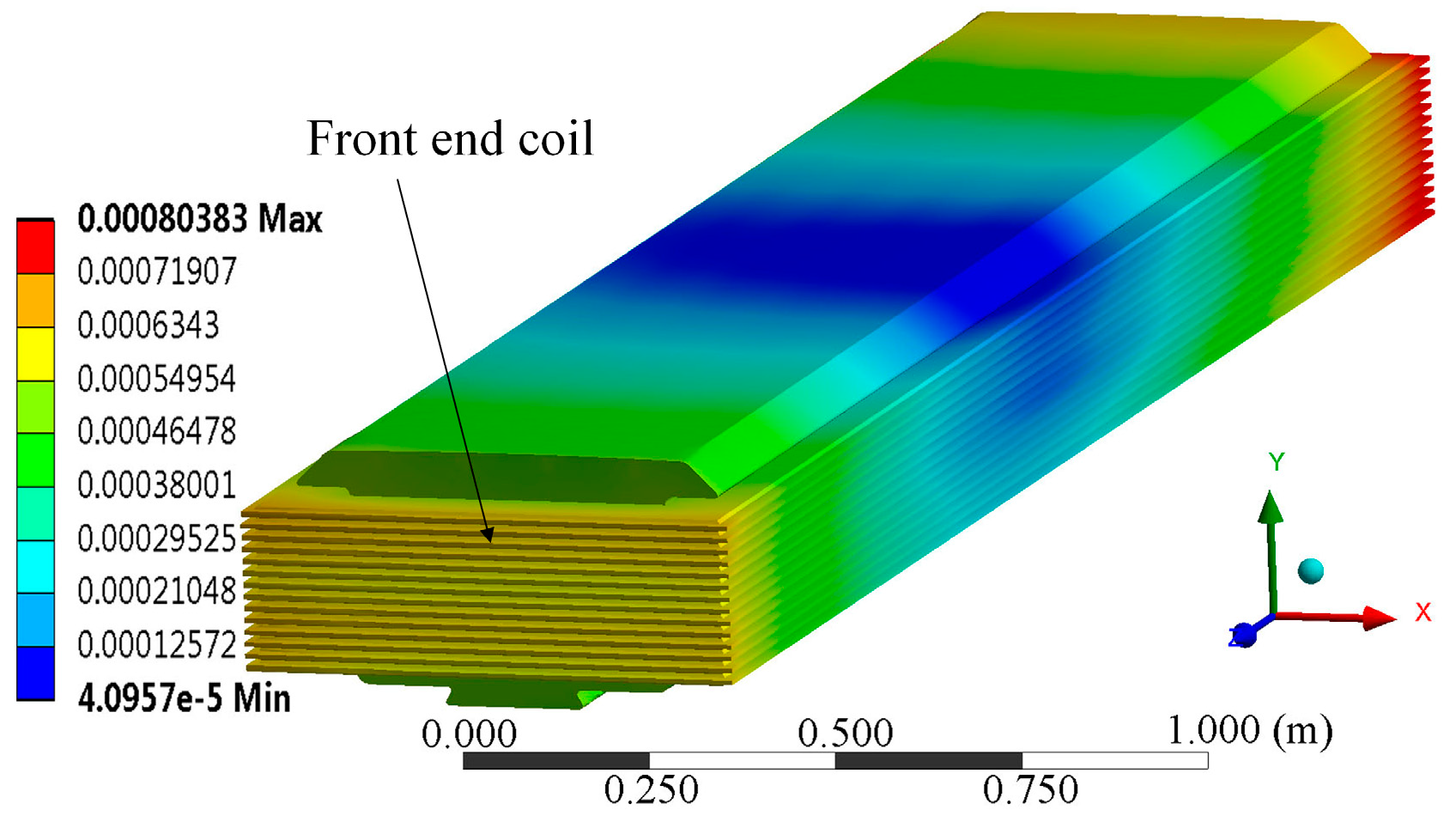
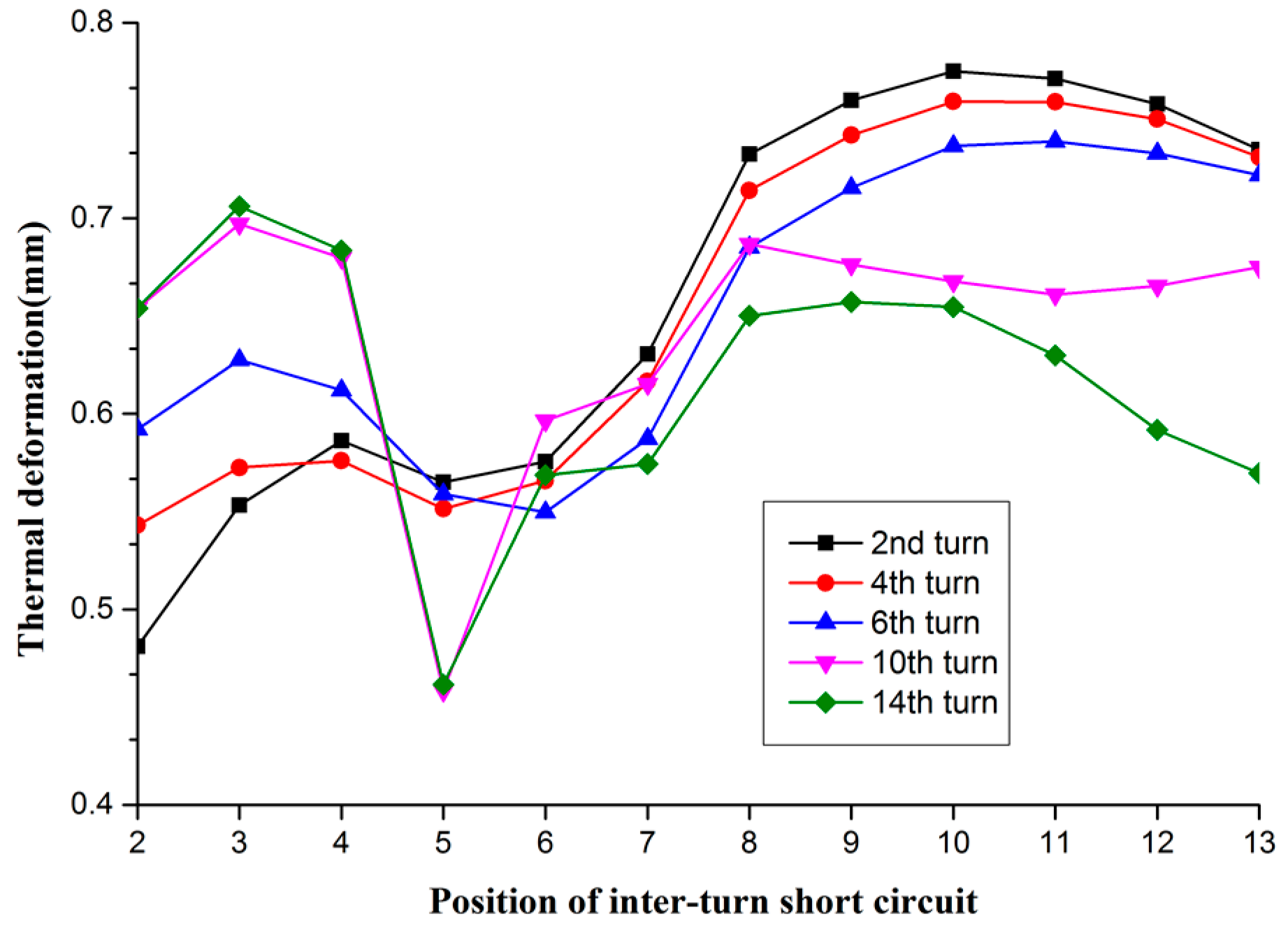


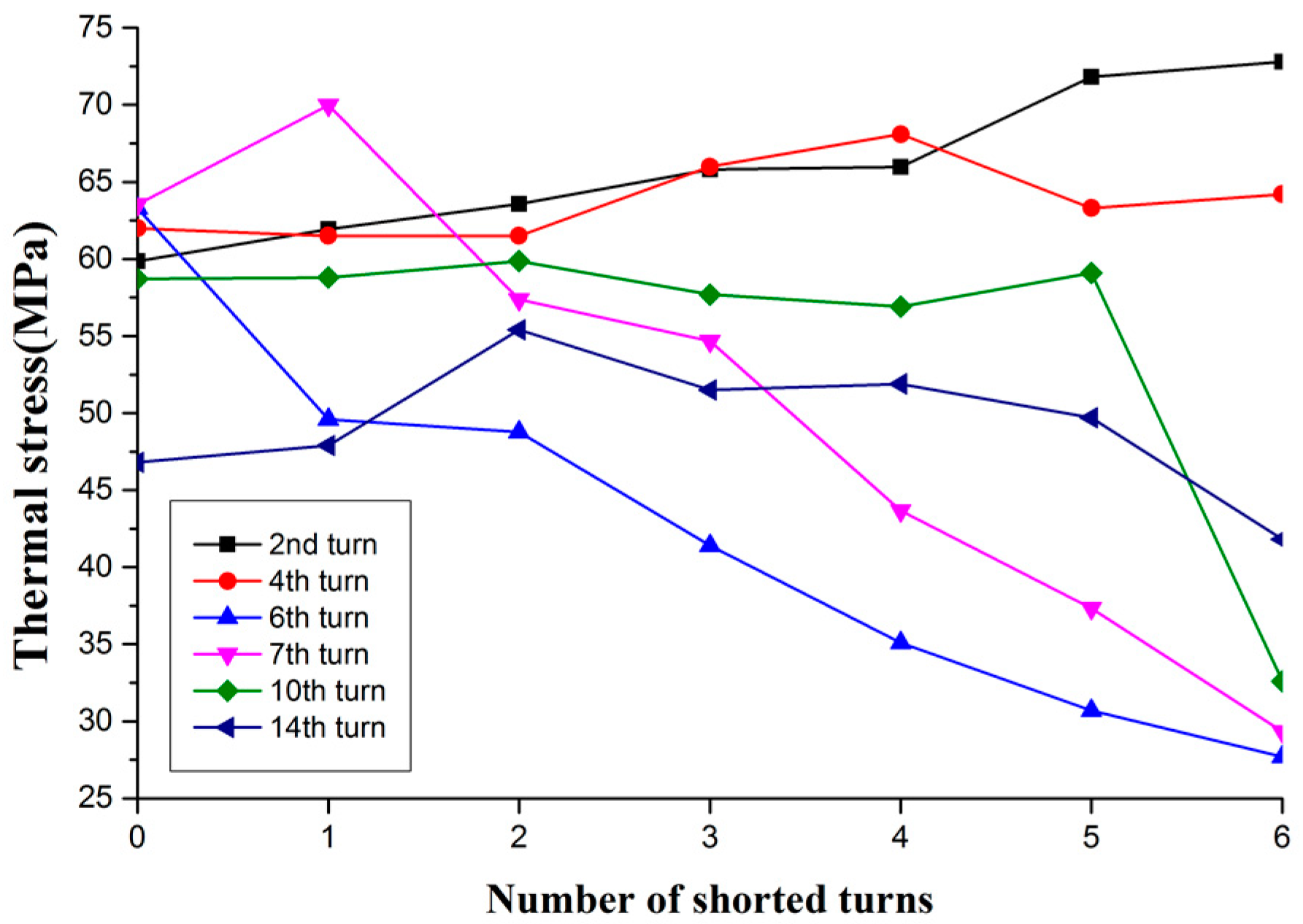
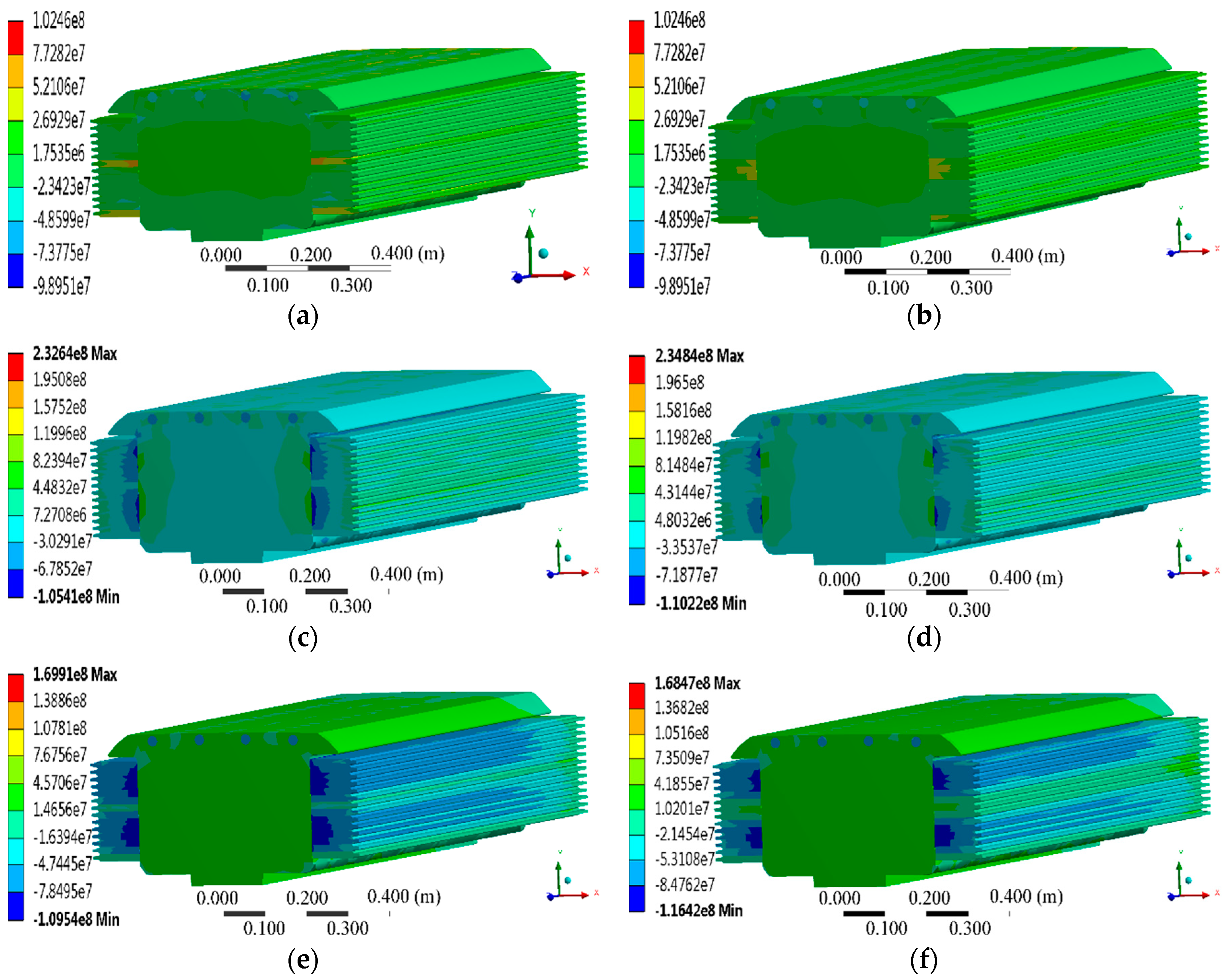

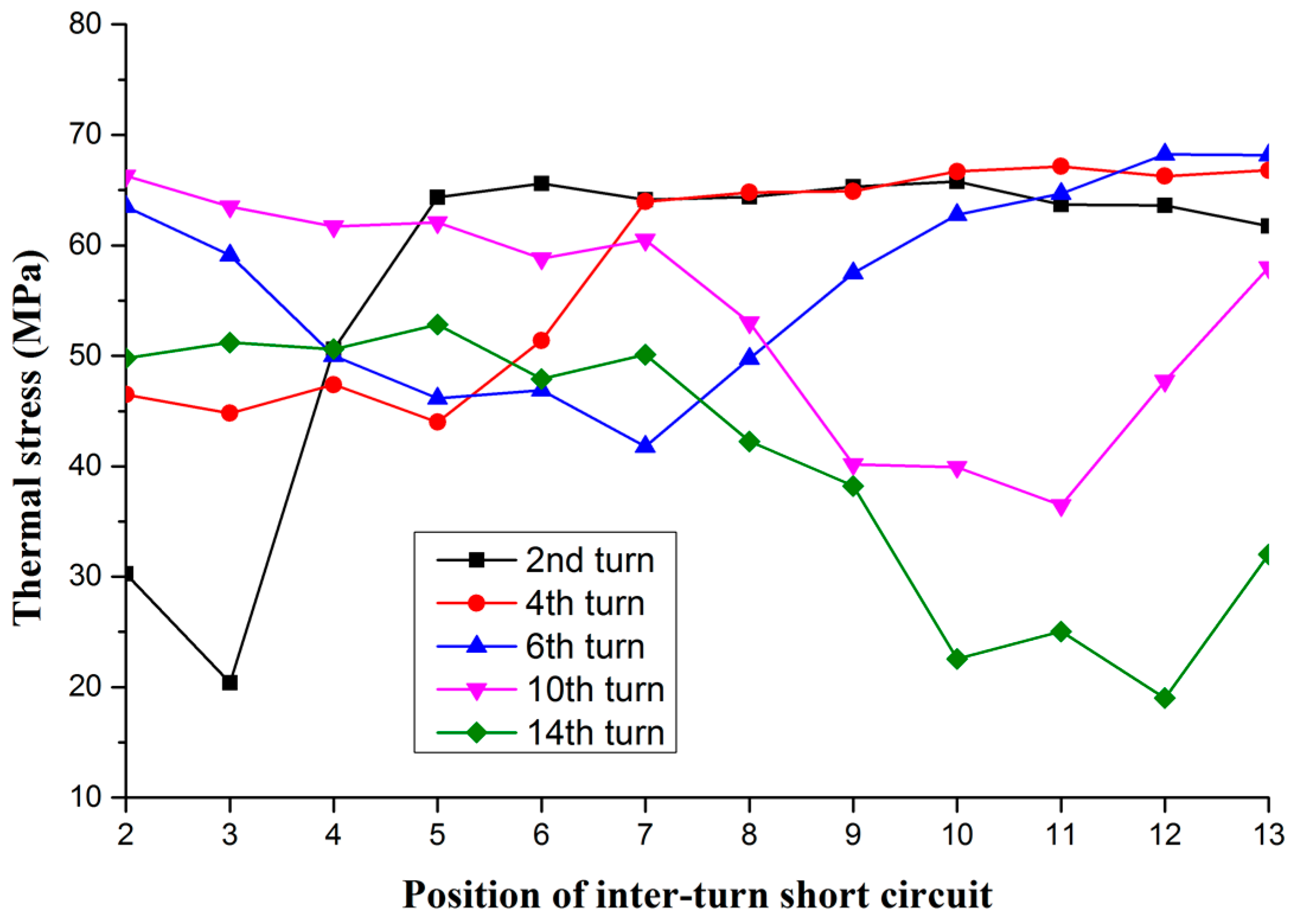
| Model | SF700-80/19760 |
|---|---|
| Rated capacity/MVA | 777.8 |
| Rated power/MW | 700 |
| Rated voltage/kV | 20 |
| Rated current/A | 22,453 |
| Rated rotating speed/rpm | 75 |
| Core length/mm | 2920 |
| Rotor outside diameter/mm | 18,742 |
| Number of winding per pole | 14 |
| Damper winding diameter/mm | 25 |
| Number of Test Point | 1 | 2 | 3 | 4 | 5 |
|---|---|---|---|---|---|
| Measured values of literature [26] | 44.3 | 45.3 | 45.7 | 46.5 | 45.4 |
| Calculated values | 43.2 | 44.5 | 44.6 | 44.7 | 43.8 |
| Number of Excitation Turns | Thermal Stress (MPa) | |||
|---|---|---|---|---|
| Upper-Layer | Middle-Layer | Lower-Layer | Normal | |
| 1 | 22.4 | -- | -- | 54.5 |
| 2 | 20.4 | 30.24 | -- | 59.9 |
| 3 | 31.9 | 33 | 32.5 | 60 |
| 4 | 44 | 47.4 | 44.8 | 61.7 |
| 5 | 39 | 49.91 | 48.2 | 61.7 |
| 6 | 41.78 | 46.9 | 46.16 | 63.14 |
| 7 | 41.28 | 53.9 | 52.2 | 63.24 |
| 8 | 46.4 | 47.23 | 50.2 | 63.1 |
| 9 | 44.8 | 48.9 | 48.17 | 62 |
| 10 | 36.46 | 39.93 | 40.18 | 59 |
| 11 | 33 | 35.15 | 31.9 | 56.9 |
| 12 | 29.35 | 29 | 21 | 53.5 |
| 13 | -- | 34 | 20.6 | 46 |
| 14 | -- | -- | 32 | 50.6 |
© 2019 by the authors. Licensee MDPI, Basel, Switzerland. This article is an open access article distributed under the terms and conditions of the Creative Commons Attribution (CC BY) license (http://creativecommons.org/licenses/by/4.0/).
Share and Cite
Li, J.; Wang, L. Calculation and Analysis of Rotor Thermal Static Field for Inter-Turn Short Circuit of Large Hydro-Generator Excitation Winding. Energies 2019, 12, 1252. https://doi.org/10.3390/en12071252
Li J, Wang L. Calculation and Analysis of Rotor Thermal Static Field for Inter-Turn Short Circuit of Large Hydro-Generator Excitation Winding. Energies. 2019; 12(7):1252. https://doi.org/10.3390/en12071252
Chicago/Turabian StyleLi, Junqing, and Luo Wang. 2019. "Calculation and Analysis of Rotor Thermal Static Field for Inter-Turn Short Circuit of Large Hydro-Generator Excitation Winding" Energies 12, no. 7: 1252. https://doi.org/10.3390/en12071252





